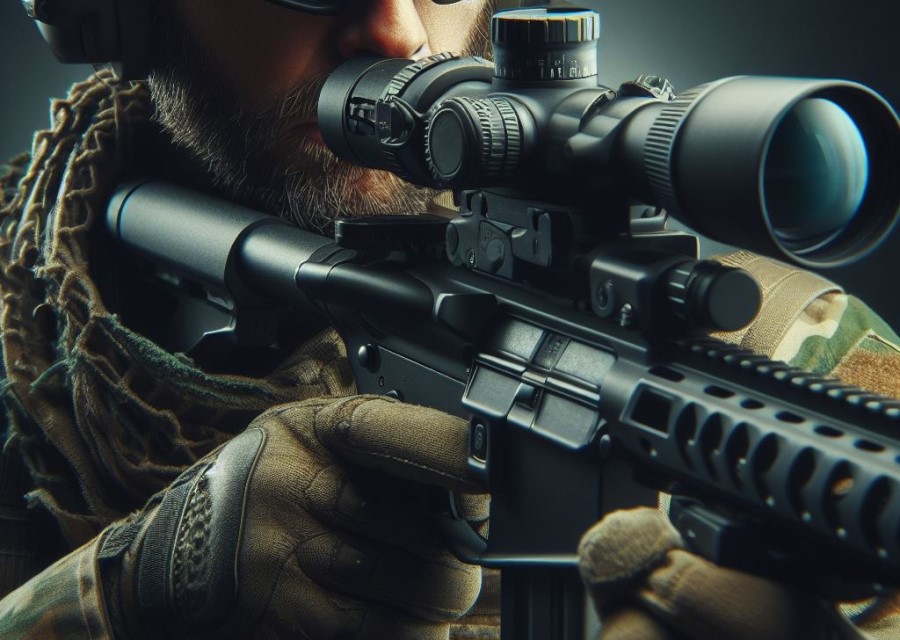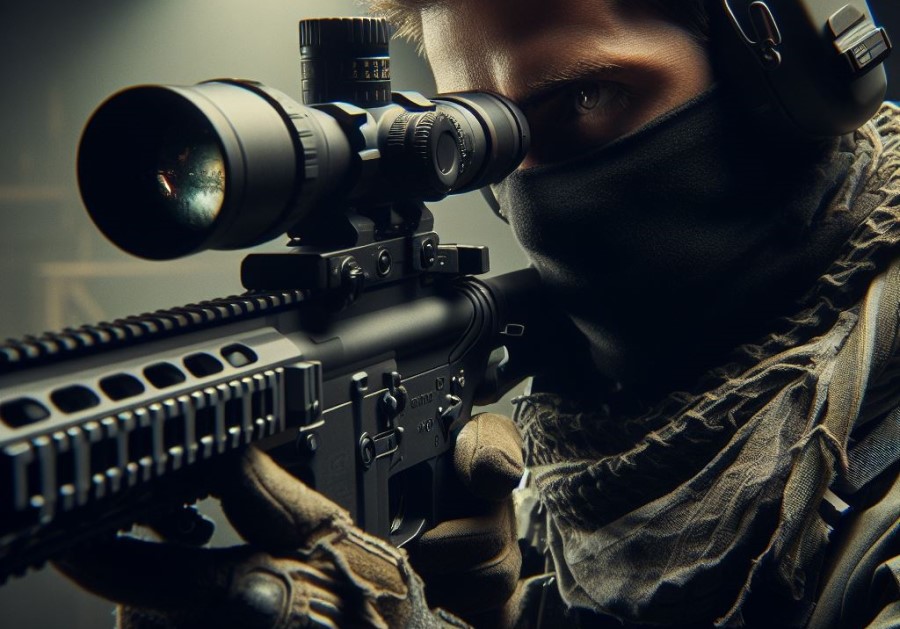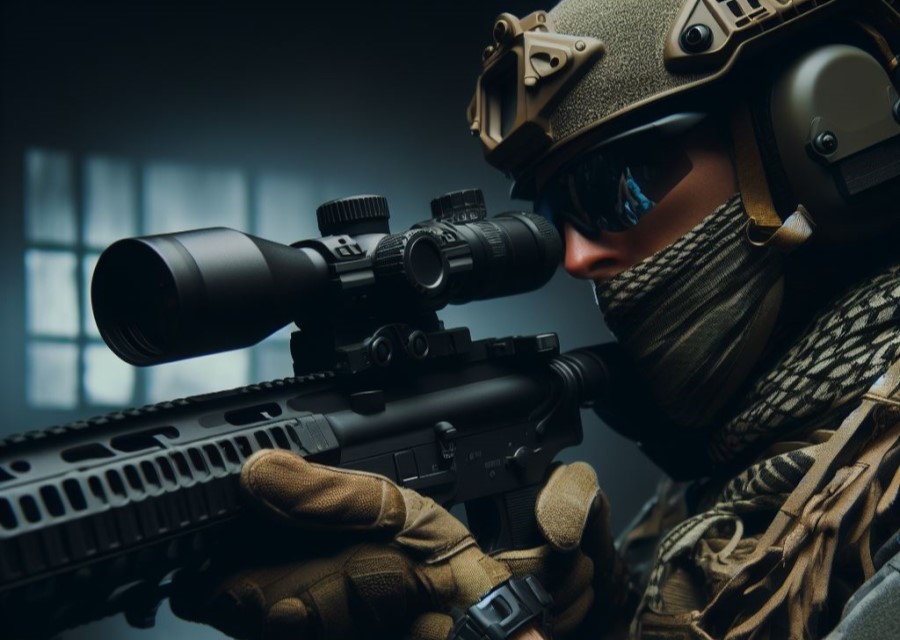A prismatic scope is a popular optical device used in various applications, including military operations, hunting, shooting sports, and outdoor activities. In this article, we will explore what exactly a prismatic scope is, how it works, and what sets it apart from other optical scopes.
A prismatic scope, as the name suggests, utilizes a prism to gather and focus light, allowing for improved target visibility and accuracy. The prism inside the scope reflects and refracts light, redirecting it to the eyepiece for the viewer to see. This optical design offers several advantages over traditional scopes, such as compactness, lightweight, and enhanced target acquisition.
Prismatic scopes find their applications in different fields, including military and law enforcement, where rapid target acquisition and precise aiming are crucial. These scopes are also popular among hunters and shooting sports enthusiasts who require quick and accurate targeting in varying environments and lighting conditions.
Using a prismatic scope offers numerous advantages. They are compact and lightweight, making them ideal for situations where portability is essential. The enhanced target acquisition capabilities of a prismatic scope allow for quick and precise aiming, resulting in improved shooting performance. Prismatic scopes often come with different reticle options and illumination settings, providing versatility and customization for different shooting scenarios.
When choosing a prismatic scope, there are several considerations to keep in mind. Factors such as magnification power, optical quality, reticle type and size, durability, and weatherproofing should all be taken into account to ensure optimal performance and longevity.
To make the most of your prismatic scope, there are a few tips to keep in mind. Proper eye relief and eye placement are essential for a clear and comfortable viewing experience. Understanding the zeroing and adjustment mechanisms of your scope is crucial to maintain accuracy. Knowing how to utilize holdover and bullet drop compensation features can greatly improve your shooting precision in various conditions.
What is a Prismatic Scope?

A prismatic scope is an optical device used for sighting and target acquisition. It is designed with prisms that provide a magnified view of the target, enabling accurate aiming and shooting. Here are some key features of prismatic scopes:
- Compact and Lightweight: Prismatic scopes are typically smaller and lighter compared to traditional riflescopes, making them a popular choice for tactical and lightweight setups.
- Fixed Magnification: Unlike variable magnification scopes, prismatic scopes have a fixed magnification level, usually ranging from 1x to 6x. This allows for quick target acquisition at close to mid-range distances.
- Illuminated Reticle: Many prismatic scopes feature illuminated reticles, offering better visibility in low-light conditions. This enhances the shooter’s ability to acquire targets quickly and accurately.
- Wide Field of View: Prismatic scopes provide a generous field of view, which is beneficial for fast-moving targets and situations that require situational awareness.
- Durability and Shock Resistance: Built with rugged materials and designed to withstand recoil, prismatic scopes are designed to withstand harsh outdoor conditions.
Fact: Prismatic scopes are commonly used in military and law enforcement applications due to their compact size, lightweight design, and ability to provide quick target acquisition in a wide range of shooting scenarios.
How Does a Prismatic Scope Work?
A prismatic scope is designed to work by utilizing a prism, which plays a crucial role in bending and magnifying light. This unique mechanism significantly improves target visibility and accuracy.
The prism, located inside the scope, works by receiving the incoming light and then directing it towards the eyepiece. It is in the eyepiece where the magnified image becomes visible. This process is made possible through the reflection and refraction of light within the prism itself.
To achieve a clear and sharp image of the target, users can adjust the focus and alignment of the prism. This allows for customization according to personal preferences.
The level of magnification offered by a prismatic scope may vary depending on the specific model being used. However, it typically ranges from 1x to 5x, ensuring versatility for different scenarios.
In addition to their functional benefits, prismatic scopes are also known for their compact and lightweight nature. These features make them a preferred choice for outdoor activities, as well as tactical situations.
Furthermore, prismatic scopes often come equipped with reticle options and illumination. These features greatly assist in target acquisition, particularly in varying lighting conditions.
What Makes a Prismatic Scope Different?
Optical design: A prismatic scope uses prisms to bend and redirect light, allowing for a more compact design compared to traditional telescopic scopes.
Eye relief: Prismatic scopes typically have shorter eye relief, meaning you need to position your eye closer to the scope to see a full field of view.
Faster target acquisition: Due to their design, prismatic scopes offer quicker target acquisition compared to other types of scopes, making them ideal for fast-paced shooting situations.
Fixed magnification: Prismatic scopes usually have a fixed magnification power, such as 3x or 5x, which can be advantageous for certain applications where a specific magnification is preferred.
Illuminated reticle: Many prismatic scopes feature illuminated reticles, which can aid in low-light or complex shooting environments.
Compact and lightweight: Prismatic scopes are known for their compact and lightweight construction, making them easier to carry and maneuver.
Wide field of view: Prismatic scopes offer a wide field of view, enabling shooters to quickly scan their surroundings and maintain situational awareness.
Durability: With their rugged construction, prismatic scopes are designed to withstand harsh conditions and recoil, ensuring long-lasting performance.
Applications of Prismatic Scopes

Discover the versatile applications of prismatic scopes! From enhancing precision in military and law enforcement operations to elevating the shooting experience in hunting and sports, these scopes have revolutionized outdoor and tactical activities.
Uncover how prismatic scopes enable professionals to achieve their objectives with pinpoint accuracy and how they enhance the performance of shooting enthusiasts. Get ready to explore the impactful role these scopes play in a variety of real-world scenarios.
Military and Law Enforcement
In the history of military and law enforcement, the use of scopes has revolutionized the way professionals engage with targets. From early telescopic sights to modern prismatic scopes, advancements in optical technology have greatly enhanced accuracy and effectiveness in the field.
The military and law enforcement agencies have recognized the importance of equipping their personnel with reliable and precise aiming devices. As a result, prismatic scopes have become an indispensable tool for these professionals, allowing them to execute their duties with efficiency and confidence.
Whether it is conducting surveillance, engaging in tactical operations, or maintaining perimeter security, prismatic scopes provide the necessary edge for military and law enforcement personnel to succeed in their missions.
Hunting and Shooting Sports
When it comes to hunting and shooting sports, incorporating a prismatic scope can greatly enhance your experience and accuracy.
- Improved Precision: A prismatic scope offers precise aiming and target acquisition, making it easier to hit your target consistently in hunting and shooting sports.
- Enhanced Clarity: The optical quality of a prismatic scope ensures clear and sharp images, even in low light conditions, improving your visibility and giving you an advantage in the field of hunting and shooting sports.
- Durable and Weatherproof: Prismatic scopes are designed to withstand rugged outdoor conditions in hunting and shooting sports. They are built to be waterproof, fog-proof, and shockproof, ensuring reliability in various weather conditions.
- Variable Magnification: Prismatic scopes offer adjustable magnification, allowing you to zoom in on your target for greater detail, or zoom out to have a wider field of view in hunting and shooting sports.
- Fast Target Acquisition: The compact design of a prismatic scope enables quick target acquisition and tracking, crucial in dynamic hunting and shooting situations.
When choosing a prismatic scope for hunting and shooting sports, consider the magnification range that suits your needs, the reticle type and size that aligns with your shooting style, and the overall durability and weatherproofing capabilities of the scope.
Remember to practice and familiarize yourself with the scope before heading out into the field of hunting and shooting sports. Adjust the settings according to the specific conditions and engage in safe shooting practices.
By using a prismatic scope in hunting and shooting sports, you can improve your precision, clarity, and target acquisition, leading to a more successful and enjoyable experience.
Outdoor and Tactical Activities
When it comes to outdoor and tactical activities, incorporating the use of a prismatic scope can greatly enhance your experience. Prismatic scopes are specifically designed to be compact and lightweight, making them perfect companions for on-the-go adventures.
Their main advantage lies in offering enhanced target acquisition, allowing you to quickly and accurately lock onto your desired target. Additionally, the reticle options and illumination of a prismatic scope provide excellent visibility, ensuring optimal performance in various lighting conditions.
No matter if you’re enjoying a hiking trip, embarking on a camping expedition, or engaging in tactical operations, a prismatic scope proves to be a valuable tool. It enables you to thoroughly survey your surroundings and effortlessly identify potential threats or targets from a considerable distance. The magnification and optical quality of the scope play vital roles in determining the clarity and accuracy with which you can observe your targets.
In the context of outdoor and tactical activities, durability and weatherproofing are critical factors to consider when selecting a prismatic scope. It is essential to choose a scope that can withstand and endure harsh weather conditions, as well as rough handling. Opting for scopes made from high-quality materials, equipped with features like waterproofing and shock resistance, is highly recommended.
Advantages of Using a Prismatic Scope

Unlock the true potential of your shooting experience with a prismatic scope! In this section, we’ll explore the many advantages that come with using this innovative optical device.
From its compact and lightweight design, to enhanced target acquisition and a wide range of reticle options and illuminations, a prismatic scope is a game-changer for shooters of all levels. Get ready to take your accuracy and precision to new heights as we dive into the world of prismatic scopes and the benefits they bring.
Compact and Lightweight
When considering a prismatic scope, its compactness and lightweight design are key factors to take into account. Portability is important – a compact and lightweight prismatic scope is easy to carry and transport, without adding unnecessary weight to your gear. This makes it perfect for long-duration activities like hiking or camping.
Maneuverability is also improved with a compact scope, as it allows for easier movement in tight or confined spaces. Whether you’re navigating through dense foliage or swiftly moving through urban environments, a compact and lightweight scope won’t hinder your movements. Additionally, the reduced weight of a prismatic scope adds to the comfort during extended use, minimizing fatigue and allowing you to maintain focus without strain.
Versatility is another advantage – compact and lightweight prismatic scopes can be mounted on various firearms without adding significant bulk or affecting the weapon’s balance. Finally, ease of storage is a plus: due to their smaller size and lower weight, compact and lightweight prismatic scopes can be easily stored in a backpack, bag, or case. They occupy minimal space, ensuring convenience when traveling or storing your equipment.
Enhanced Target Acquisition
Enhanced target acquisition is a crucial feature of prismatic scopes, improving precision and accuracy in various applications. Here are some key aspects to consider:
- Optical clarity: Prismatic scopes offer excellent clarity and resolution, allowing for precise target identification and tracking. The high-quality lenses and prisms optimize light transmission, resulting in a clear and sharp image.
- Reticle design: A well-designed reticle plays a vital role in enhanced target acquisition. Prismatic scopes often feature illuminated reticles with multiple brightness settings, enhancing visibility in different lighting conditions. The reticle’s shape, such as a simple dot or a complex crosshair, should align with your shooting preferences.
- Magnification range: The magnification capabilities of a prismatic scope impact enhanced target acquisition. Consider the range of magnification required for your intended use. Higher magnifications can be beneficial for long-range shooting, while lower magnifications allow for a wider field of view and quick target acquisition at closer distances.
- Rapid target acquisition: Prismatic scopes are designed to provide quick target acquisition. Look for scopes with a generous eye relief, enabling rapid sighting and aiming. Additionally, a wide field of view helps to locate and track targets swiftly.
- Durability: Opt for a prismatic scope with a rugged and durable construction to withstand harsh environments and impacts. The scope should be weatherproof and capable of handling recoil from firearms without compromising accuracy.
- Mounting options: Ensure that the prismatic scope you choose is compatible with your firearm’s mounting system. Consider factors such as scope ring size and mounting height for a secure and precise attachment.
By considering these factors, you can select a prismatic scope with enhanced target acquisition capabilities that perfectly suits your shooting needs.
Reticle Options and Illumination
When choosing a prismatic scope, Reticle Options and Illumination are important factors to consider.
- Dot: Some prismatic scopes offer a simple dot reticle with illumination. This can be helpful in low light conditions or when targeting small objects.
- Mil-Dot: For long-range shooting, a mil-dot reticle with illumination can assist in calculating bullet drop and windage adjustments.
- BDC Reticle: Some prismatic scopes feature a bullet drop compensation (BDC) reticle with illumination. This reticle is calibrated for specific bullet trajectories and can aid in accurate aiming at different distances.
- Crosshair: Crosshair reticles with illumination are versatile and commonly used for various shooting applications. They provide a clear aiming point without distractions.
- MOA Reticle: MOA reticles with illumination are popular among precision shooters. The illumination helps in low light conditions and enhances visibility.
When choosing a prismatic scope, consider your specific needs and shooting style. If you frequently shoot in low light conditions, a reticle with illumination can be advantageous.
Additionally, the type of reticle you choose should align with your shooting goals and preferences. It’s important to note that not all prismatic scopes offer illumination, so make sure to check the specifications before making a purchase decision.
Considerations when Choosing a Prismatic Scope

Photo Credits: Paintballbuzz.Com by Paul Flores
When choosing a prismatic scope, there are several key considerations to keep in mind. From magnification and optical quality to the type and size of the reticle, as well as durability and weatherproofing, each aspect plays a crucial role.
So, let’s dive into the details and explore what makes a prismatic scope stand out in terms of its performance and functionality. Stick around to learn how these factors can greatly impact your shooting experience and overall satisfaction with your chosen scope.
Magnification and Optical Quality
When selecting a prismatic scope, it is essential to take into account both the magnification and optical quality. The level of magnification defines the size and clarity of the target, while the optical quality impacts the clarity and sharpness of the image. A higher magnification allows for superior target identification and engagement at longer distances, but it may also result in a narrower field of view and reduced image brightness.
Alternatively, optical quality plays a crucial role in ensuring minimal distortion and exceptional light transmission. Insufficient optical quality can lead to blurry images and decreased visibility. To ensure a satisfactory experience, it is important to consider the intended use and shooting conditions when determining the appropriate magnification level. Furthermore, it is recommended to seek prismatic scopes equipped with high-quality glass and advanced optics to enhance the optical performance.
By considering both magnification and optical quality, you can make an informed decision and select a prismatic scope that caters to your specific needs, providing clear, precise, and accurate aiming.
Reticle Type and Size
When considering a prismatic scope, the reticle type and size are important factors to consider for optimal performance.
The most common reticle types are duplex, mil-dot, and BDC (Bullet Drop Compensating). The size of the reticle depends on personal preference and the intended use of the scope.
The duplex reticle is a simple crosshair design, which is effective for general shooting and hunting purposes. Reticle sizes can range from small and fine to larger and bold, depending on the user’s preference and shooting conditions.
The mil-dot reticle features dots spaced along the vertical and horizontal axes, allowing for range estimation and holdover adjustments. Smaller reticle sizes are suitable for precision shooting, while larger sizes may be easier to acquire quickly for fast-paced shooting scenarios.
The BDC reticle is designed to compensate for bullet drop at different distances, with additional aiming points below the center crosshair. Reticle size should be chosen based on the shooting distance and target size.
For specialized uses such as long-range shooting or tactical applications, there are reticle designs tailored to specific needs, such as Christmas tree, horseshoe, or MIL-Hash reticles. When selecting a reticle size, consider the level of precision desired and the target’s size or distance.
Ultimately, the choice of reticle type and size depends on the shooter’s preferences, shooting style, and the specific requirements of the intended applications.
Durability and Weatherproofing
When it comes to prismatic scopes, durability and weatherproofing are key factors that must be taken into account to ensure excellent performance in different conditions.
Prismatic scopes are specifically designed to withstand heavy use and tough conditions. These scopes are constructed to resist moisture, dust, and other environmental elements.
They often feature a sturdy build, using materials like aircraft-grade aluminum, which enhances their overall durability.
In order to maintain clarity and prevent fogging, weatherproofing is achieved through the use of O-ring seals and nitrogen purging.
Some scopes also come with shockproof capabilities to withstand the recoil generated when used with firearms. This makes them suitable for use in a wide range of weather conditions, including rain, snow, or hot and humid environments.
Manufacturers may provide durability ratings or certifications, such as MIL-STD 810G, to assure customers of the high quality of their products. Weatherproofing ensures that the scope remains fully functional and reliable, even in challenging outdoor situations.
When selecting a prismatic scope, it is important to carefully consider the level of durability required based on its intended use and the specific environmental conditions it will be exposed to.
Having proper weatherproofing guarantees that your investment in a prismatic scope will be safeguarded no matter the outdoor scenarios you encounter.
Tips for Using a Prismatic Scope
Here are some tips for using a prismatic scope effectively:
- Make sure to properly mount and align the scope with your firearm and the barrel.
- Practice the correct eye relief by positioning your eye at the proper distance from the eyepiece.
- Adjust the focus to obtain a clear and sharp image according to your vision.
- Utilize the reticle for accurate aiming by aligning it with your target.
- If using the scope in low light conditions, modify the brightness settings to improve visibility.
- If available, consider using the bullet drop compensation feature to compensate for the bullet trajectory at different distances.
Fact: Prismatic scopes are renowned for their compact design and fixed magnification, making them popular for close to mid-range shooting.
Frequently Asked Questions
1. What is a prismatic scope and how does it differ from a traditional lens scope?
A prismatic scope is a compact optic for tactical rifles that uses a glass prism instead of traditional lenses to focus the image. Unlike traditional lens scopes, prismatic scopes typically offer fixed magnification in the lower range, usually from 1x to 5x. They differ from traditional lens scopes in their smaller package, increased durability, and illuminated reticles.
2. How does a prismatic scope compare to a red dot sight?
A prismatic scope differs from a red dot sight in several ways. While both provide an illuminated reticle, a prismatic scope often has a higher magnification and an eye relief, making it more suitable for tactical shooting. Red dot sights, on the other hand, are better for fast-paced shooting, as they allow for both eyes open and have no eye relief.
3. Can a prismatic scope be used for casual range shooting?
Yes, a prismatic scope can be used for casual range shooting. It offers a compact size, easy-to-use red dot aimpoints, and a relatively fast target acquisition, making it suitable for casual shooting at the range.
4. What are the pros and cons of using a prismatic scope?
Pros of using a prismatic scope include some level of magnification, a smaller package, increased durability, illuminated reticles, and suitability for shooters with astigmatism. However, there are some cons to consider, such as a magnification limit of around 5x, heavier weight compared to red dots, limited parallax and eye relief forgiveness, and higher price point.
5. What are some popular models of prismatic scopes?
Some popular models of prismatic scopes include the Primary Arms SLx Cyclops Gen 2 with ACSS, Monstrum 2x Prism Scope, Primary Arms GLx 2X Prism with ACSS Gemini 9mm Reticle, Vortex Spitfire HD Gen 2 3X, Primary Arms SLx 3X MicroPrism, Swampfox Saber, and Swampfox Trihawk.
6. How does a prismatic scope compare to a traditional red dot sight in terms of functionality and features?
A prismatic scope offers several advantages over a traditional red dot sight, such as the ability to magnify the image for a larger sight picture and extended effective range. It also features an illuminated and etched reticle, which can be viewed without batteries or concerns about fiber optic issues. Additionally, the prism design provides a brighter and sharper image, allowing for quick target acquisition. However, a prismatic scope may have a shorter eye relief and larger parallax error compared to red dot sights, and its magnification tops out at around 5x.

